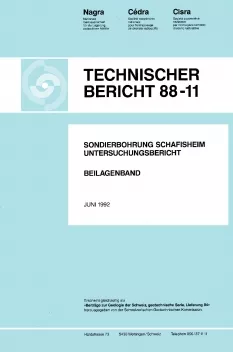
Technischer Bericht NTB 88-11
Sondierbohrung SchafisheimUntersuchungsbericht
In 1980, Nagra (the National Cooperative for the Storage of Radioactive Waste) launched an extensive geological investigation programme covering an area of some 1,200 km2 in Northern Switzerland. The aim of the programme was to collect the geological information necessary for assessing the suitability of the crystalline basement as a disposal medium for high-level radioactive waste. The wide range of investigations performed can be divided logically into a deep drilling programme, geophysical reconnaissance of the rock formations and structures in the region, a hydrogeological programme for investigating water flow paths deep in the bedrock and a neotectonic programme for identifying active crustal movements in the area.
The Schafisheim borehole was the fourth, and most southerly, in the deep drilling programme. The drill-site (coordinates 653'620/246'760; 421.2 m a.s.l.) lies within the community of Schafisheim in Canton Aargau, some 4 km to the south-west of Lenzburg. The final depth of the borehole was 2,006.5 m.
The aim of the Schafisheim borehole was to drill through the sedimentary overburden and around 500 m deep into the crystalline basement. A wide range of investigations was carried out in the borehole itself, as well as on drillcores and water samples. The most up-to-date methods were used to provide a detailed picture of the geology of the basement and the deep groundwater regime.
Drilling began on 26.11.1983 and continued, with regular interruptions for scientific investigations, until 29.6.1984. Extensive testing continued in the following months and a multipacker system was finally installed between 18.2.-24.2.1985, to allow long-term monitoring of the deep groundwaters. This system had to be replaced since the packers failed after only one month of operation. The definitive multipacker system has now been in operation since 22.6.1987 and allows hydraulic conditions to be observed in the Lower Freshwater Molasse (Untere Süsswassermolasse), the upper Muschelkalk, the Buntsandstein and sections of the crystalline. The investigation programme was carried out more or less completely as planned, and with a considerable degree of success.
The drilling and investigation programmes were planned and managed by Nagra employees with the cooperation of external advisers. More than 40 technical colleges, contractors and service companies from Switzerland, Germany, France, Great Britain, the Netherlands, Canada and the USA, representing a total manpower of more than 150 scientists and technicians, were involved in running the programmes.
This report is a summary of the most important results obtained during the course of the programme at Schafisheim. The series of investigation reports for the deep boreholes (Böttstein, Weiach, Riniken, Leuggern, Schafisheim, Kaisten and Siblingen) is structured in such a way that cross-comparisons can be made between the results and datasets for the different locations. The conclusions to be drawn from the data will be reserved for a final synthesis report. Detailed documentation of individual experiments is provided in Nagra's Technical Report series (see NTB list at the end of this report).
Komplette Zusammenfassung / Résumé complet / Full abstract:
NTB 88-11 Zusammenfassung – Résumé – Summary.pdf
